Nov 28, 2018 | ancient, coins, commentary, foreign, legal, policy
I said that if we do not act that we would become victims!
A man came into my shop the other day. Like all new visitors, my assistant greeted him with her usual charm while he looked at the eclectic inventory in the showroom.
The man was different than others. On a slow morning, he lingered around the set of auction catalogs I have for sale while saying little to my assistant who felt uncomfortable with this man in the shop. Another customer came into the shop and my assistant took care of them while I watched this gentleman.
After a while, he came to me and, in a heavy accent I could not identify, asked if I was the store’s owner. He pulled out a few folded pieces of paper and showed me a sheet with the article “Coin jewelry is not legal everywhere” I wrote on this blog in April 2016.
He pointed to one of the pictures and asked if I knew anything about the coin. I asked why and he said he was interested in purchasing one. For some reason, I had a feeling that he might have had other interests in mind.
-
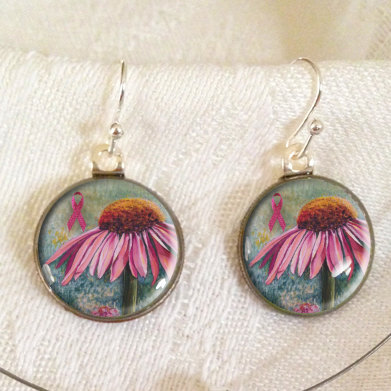
-
Resin ear rings made by InspiringFlowers using Roosevelt dimes
-

-
Hummingbird cut from a Trinidad and Tobago penny by SawArtist
-

-
1996 Half Dollar Ring by LuckyLiberty
Examples of the coin jewelry from the orignal post
I explained to that I do not carry a lot of jewelry since it is not a specialty of my business. When I do have jewelry in stock it does not sell well. He opened the paper and asked if I knew anything about the jewelry on the page.
I explained that the article he is holding is from a blog post I made explaining how some countries have restrictions regarding the usage of their coins for jewelry. When he pressed for more information I said that it was noted in the posting that the images came from Etsy and I do not know any of the sellers. Their goods were used as an example for the posting.
It felt like I was being interrogated. I asked if he was a member of law enforcement or any other government investigative agency, he mumbled something I did not like. I asked him to leave. My assistant had called the police.
The police arrived and escorted the man out of the shop and questioned him before letting him drive away in his own vehicle. I noted the license plate. The officer came inside and said that this will be handled elsewhere and that I was not to report it any further.
About a week later, I was visited by someone representing a federal agency and a member of federal law enforcement who wanted to question me about the incident. After they produced proper identification, we went into my office to discuss the matter.
I was told that the man who came into my shop was an agent for an unnamed foreign government. This government has been visiting collectible stores and shows to intimidate people into “returning cultural items” from that country. The country that this person represents considers this legal even though it violates my Fifth Amendment right of due process.
Apparently, the person that visited my shop is responsible for the “confiscation” of items from more than a dozen antiques and collectibles shops in the mid-Atlantic region.
It is not the first time we have heard the foreign governments have tried to go around the United States’ right of due process by trying to confiscate coins under the guise that they are “national treasures.” In 2013, I wrote “Why you should care about restrictions on collecting ancient coins” sounding an alarm for people to act.
People did not act or act strongly enough. It has allowed a foreign government to pervert the 1970 UNESCO Convention’s intent to steal legally obtained inventory from United States businesses they claim are national treasures.
In the next few weeks, I will be writing a short position paper to present to the American Numismatic Association in order to get them to work to protect collectors. It is time that the ANA and other numismatic organizations work together to protect the hobby and stop kowtowing to every country who wants to retroactively make a claim against United States business because a foreign government said so.
Sep 4, 2018 | education, foreign, tokens
Now that I am running a collectibles business, I see a number of interesting items coming into the shop.
Last week, someone came into the shop with items that she wanted to sell in order to downsize prior to moving. One of the items was a small plastic bag of foreign coins. The bag contained a lot of low-value base metal coins that would trade for under one dollar from a dealer’s junk box.
Although I do not keep a large inventory of coins, I have a basket I fill with foreign coins for anyone who wants to look through them. I will sell the coins for 25-cents each even if they are worth more. When parents come into the shop with their children, I will let the kids pick out a coin. I challenge them to go online and learn what they can about the coin.
Sometimes, my assistant and I will look through the basket for something interesting. While my assistant is not a collector, she knows I am and looks for specific items I am looking for (more on that another time) and anything that looks interesting.
After moving furniture in the warehouse, I returned to my desk and found a small pile of coins. Some were part of the coins I was looking for and a token with the date of 1895. What is this coin?
-
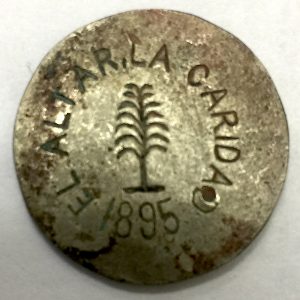
-
Obverse of a token from Hacienda El Altar and La Caridad. The plant in the center is likely a cane that was popular in the region.
-
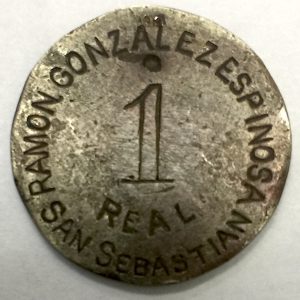
-
Reverse of a Hacienda El Altar and La Caridad token declaring they were owned by Ramón González Espinosa from San Sebastián and is worth 1 Real.
On the obverse and above the date is a tree. The legend around the coin says “EL ALTAR, LA CARIDAD.” On the reverse, it gives the denomination of “1 REAL” and the legend says “RAMON GONZALEZ ESPINOSA” and “SAN SEBASTIAN.” Immediately, I think this is a Spanish coin.
San Sebastián is a coastal city in the Basque region of northern Spain close to the French border. Although there is evidence of human settlement from at least 24,000-22,000 BCE, the earliest recorded evidence dates to 1014 and the monastery of St. Sebastián.
But there was no reference of a 1 real coin being issued in the region in the late 19th century or anyone in the region named Ramón González Espinosa.
Who was Ramón González Espinosa? Trying an Internet search of that name finds people with that name in California, Texas, and elsewhere around the world. Searching for Espinosa and San Sebastián also lead to a lot of irrelevant results.
Next was to figure out what El Altar and La Caridad represent. El Altar is “The Alter” in Spanish and La Caridad translates to “The charity.” Could this have been a token used to try to raise money in Spanish speaking country other than Spain?
Just to see what would happen, rather than using google.com, I went to google.com.mx, the site that serves Mexico and Latin America. I entered the information for all of the legends and searched. When too many items came up and my rudimentary Spanish found that they were irrelevant, adding quotes around each phrase lead found an interesting page.
On a blog that is written by a Venezuelan numismatist, there was an article with an image of the same token. Using translation software, I was able to obtain enough information to learn more about the token.
During the late 19th century, Venezuela was undergoing a financial crisis that caused a severe coin shortage. The situation became so bad that the haciendas, plantations in Venezuela, could not pay their workers. To help solve the problem, hacienda owners would create their own tokens to act as promissory notes. They would pay their workers using these tokens. When coins were available, the hacienda owner would pay the merchants.
These tokens circulated as money throughout the region.
The token we found was from the Hacienda El Altar and La Caridad, both were the properties of Ramón González Espinosa. Espinosa’s properties were located in Aragua State
The haciendas were in San Sebastián de los Reyes (Saint Sebastian of the Kings) in Aragua State. The town is located on the Guárico River that leads to the Caribbean Sea. El Altar and La Caridad were livestock farms.
It is unusual for the names two haciendas to appear on a single token. According to references about other tokens from this era, when the same person owned multiple haciendas they had tokens made for each of their properties to distinguish the accounts from each other. Since there were no other references for tokens with more than on hacienda, it is not known as to why Espinosa created only one token.
Most tokens from this era were made using a copper-nickel alloy that ranged from 40-60 percent nickel. Most were thin discs and had different shapes. Hacienda tokens ranged in value from ½ Real to 5 Reales. Tokens from Hacienda El Altar and La Caridad were issued in ½, 1, 2, and 4 Reales.
The Venezuelan government continued to have a difficult time producing enough coinage. After Cipriano Castro seized the government in Caracas, he contracted with the Mexico City Mint to produce low denomination copper coins. In 1902, Venezuelan government contracted with the U.S. Mint to produce lower denomination silver coins.
Slowly, there was enough of a coin supply that it ended the need for hacienda tokens. But they continued to circulate because hacienda owners used it as a way to control their workers. When Juan Vicente Gómez overthrew Castro, who left Venezuela in 1908 for medical treatment in Germany, he instituted a rule to end the circulation of these tokens by ordering the hacienda owners to buy back the tokens using state currency.
It is estimated that over 10,000 tokens were once in circulation. After the order was given to redeem the tokens most were melted and used for other purposes.
Although it is rare to find one, they are not worth much in the numismatic market. However, finding one allowed me to learn more about its origin, hacienda tokens, and how the United States helped in ending this practice.
In other words, yet another reason why numismatics is a fun hobby!
Sep 2, 2018 | coins, foreign, news, tokens
There is always something in numismatics that can be used to teach us about history. This past week it was reported that Russian archeologists found a rare “beard kopek.” It was a coin that men had to buy if they wanted to remain unshaven under the rule of Peter the Great.
-
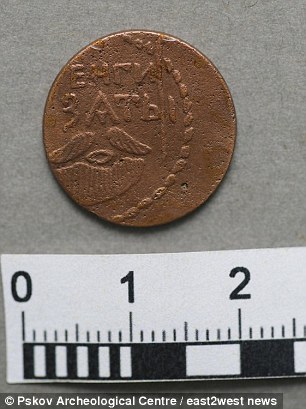
-
Obverse of Beard Tax copper token issued under the reign of Czar Peter the Great.
-
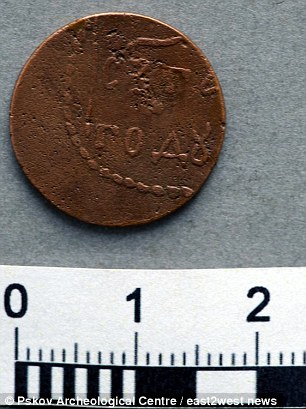
-
Reverse of the Beard Tax token. Note the off-center strike on this hammered token.
Peter rose to power at the age of 17 in 1689, but the arcane succession rules of Russia did not allow him to actually rule until his mother died in 1694. Then, he had to be co-ruler with his brother Ivan V until Ivan died in 1696. That is when Peter took over.
Once Peter became the sole czar he implemented sweeping reforms to modernize Russia. He thought that in order to become a power similar to those of Western Europe, Russian society had to evolve. Using western advisors and his command of the military, he forced reforms on the country including violently suppressing uprisings by those who did not agree with him.
To enforce his idea of modernization, he introduced western dress to his court and required all government officials to adopt this more modern style of dress. Robes and beards were no longer accepted under Peter’s rule. In order to enforce his idea, Peter began to levy taxes on people who would not comply. If you wanted to keep your beard you had to pay a tax. Once you paid a tax you would be required to carry around a token saying that you paid the tax.
The copper token found in Russia was one of those beard tax tokens. It has an image of a beard and mustache with the words “Money Paid” (in Russian) surrounded by a beaded border. If you wanted to keep your facial hair, you paid the tax and had to carry around the token as proof.
Reports claim that this is only the second known Beard Tax token to exist with the other one being in The State Hermitage Museum in Saint Petersburg, Russia. However, a silver version of the token was sold by Heritage Auctions in September 2017 as part of the Long Beach Expo World Coins Signature auction. The hammer price for that token was $3,000.
Even if there were two more found, it would still be a rare token!
And now the news…

August 27, 2018
Aaron Coulson was given the silver coin in a Sutton Coldfield pub – and thinks it's worth at least £100  → Read more at birminghammail.co.uk
→ Read more at birminghammail.co.uk

August 27, 2018
In 1698, Tsar Peter the Great of Russia, as he would come to be know, was waging a war on beards. In an attempt to modernize his empire and make it more like the west after spending years exploring Europe in disguise, Peter instituted a tax on facial hair.  → Read more at popularmechanics.com
→ Read more at popularmechanics.com

August 27, 2018
The United States Mint has issued an open call for artists to design the nation’s coins and medals as part of its its Artistic Infusion Program. The government is particularly interested in artists who will “bring innovative perspectives and utilize symbolism in their work to clearly and evocatively convey subjects and themes,” according to the program’s press release.  → Read more at news.artnet.com
→ Read more at news.artnet.com

August 28, 2018
AUGUSTA, Maine (WABI) – Attention all Maine artists: The Maine Bureau of Veterans' Services has an important job for you. They're looking for an artist to design a coin for post-Vietnam War and peacetime veterans.  → Read more at wabi.tv
→ Read more at wabi.tv

August 30, 2018
A MAN uncovered a horde of Roman coins buried in farmland. Allan Hughes, of Wrexham, found five silver Denarii coins dating back nearly 2,000 years while out searching with a metal detector on arable land in Cockshutt, near Ellesmere.  → Read more at leaderlive.co.uk
→ Read more at leaderlive.co.uk

September 1, 2018
The South African government is considering a range of initiatives to increase the demand for platinum-group metals (PGMs), including the development of a Mandela Platinum Coin. The proposal to develop a Mandela Platinum Coin is based on the international success achieved by the Kruger Rand, South Africa’s Mineral Resources Minister Gwede Mantashe said at the Africa Downunder conference, in Perth.  → Read more at miningweekly.com
→ Read more at miningweekly.com

September 2, 2018
A First Century silver Roman coin uncovered on land in Shropshire has been declared treasure trove at an inquest.  → Read more at shropshirestar.com
→ Read more at shropshirestar.com
Aug 29, 2018 | coins, commentary, counterfeit, ethics, foreign
A regular reader was upset about the appearance of hypocrisy at the
World’s Fair of Money. On one hand there was a lot of talk about counterfeit collectibles from China. On the other hand, there was a lot of hoopla over the Panda with special designs and privy marks honoring the World’s Fair of Money. In this episode of “LOOK BACK,” I update what
I wrote in February 2014 about China and counterfeits.
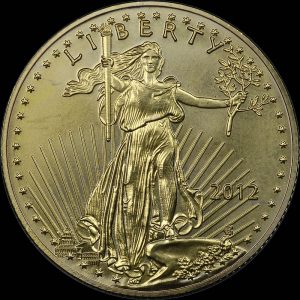
Front of a counterfeit 2012-dated American Eagle $50 denomination one-ounce gold bullion coin. (Photo courtesy of Numismatic Guaranty Corporation.)
Every coin minted by the U.S. Mint is legal tender and are legally an instrument of the government. Although the Trade dollar was demonetized in 1876, it was remonetized as part of the Coinage Act of 1965 making it legal tender (31 U.S.C. § 5103) for trade in the United States. This means that it is legal to spend an 1873 Trade Dollar for $1 of goods and services even though the coin is worth more than its face value.
To protect its currency, the United States has anti-counterfeiting laws that makes it illegal to counterfeit the nation’s money and use in commerce. For collectible coins and currency congress passed and has since updated the the Hobby Protection Act (15 U.S.C. § 2101 et. seq.). These laws protect the money supply when it is a collectible and not an instrument of commerce.
In the United States, laws are cumulative. Once passed, they remain the law until repealed or declared unconstitutional by the courts. This is not the way in many other countries. In many countries, when a new government takes power they are given the authority to rewrite the laws. It is expected to happen within authoritarian governments but it is common in many parliamentary democracies.
The People’s Republic of China has been run by the Communist Party since 1949. Their rules and laws have changed significantly when the Communist Party came into power. One of their first rules was to demonetize the money produced by the Republic of Chin and issued renminbi, the “people’s currency.”
Since then, it has been the practice of the chairman of the Communist Party to demonetize non-current issues of coins and currency as part of their economic control policies. Based on the current Chinese economic system, all coins struck since 1955, the first issued under the current government, are legal tender. Currency printed since 1999, the fifth series is the only legal tender notes. Any other coin or currency note has been demonetized.
Under Chinese anti-counterfeiting laws, it is illegal to duplicate any legal tender coin or currency note for any reason. However, since coinage from previous regimes is no longer legal tender, it is legal to strike coins with those designs. Chinese laws do not recognize the collection of these coins as a market to protect.
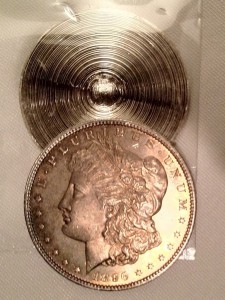
An example of a Morgan Dollar cut in half to match a date with a mintmark to have the coin appear something it is not. Coin was in a counterfeit PCGS slab and caught by one of their graders.
Chinese law does not recognize the perpetual legal tender status of every coin issued. Chinese law also recognizes that counterfeiting current issues of other countries is also illegal because someone could try to use the coin in commerce where it is legal to use foreign currency. This means that in China, it would be illegal to reproduce a presidential dollar or Washington quarter, but producing Morgan dollars or a set of 1921 Walking Liberty half-dollars is legal in China because these are coins no longer issued in the United States.
When China is asked to assist the United States to stop the counterfeiting of coins, China does not recognize that its people are doing anything wrong. The coins are no longer being made, they are not in circulation, and their laws allow people to make copies of these coins. The only laws that China has regarding collectibles are laws protecting antiquities and cultural properties. This means that you cannot duplicate a Ming Dynasty vase and try to pass it off as real but it is legal to reproduce a Rembrandt masterpiece since he is not Chinese and his work was not made in China.
A trade attorney that was originally consulted for this article confirmed that when it comes to these issues, Chinese law is very protectionist. The claim is that they follow their laws consistently regardless of outside circumstances and they refuse to make exceptions citing the complication with enforcing their laws in a country with a population of more than 1.3 billion people.

PCGS representatives showed Congressmen counterfeit U.S. coins in counterfeit PCGS holders during their recent meetings in Washington, DC. (Photo courtesy of PCGS.)
The Chinese government has no incentive to help the United States or any other country fight counterfeiting in what is perceived by the Chinese as a small market problem. To put the resources necessary into what looks like a petty crime for selling inexpensive, non-circulating duplicate coins that are within Chinese law to manufacture is considered not worth their resources.
While there is anecdotal evidence that the Chinese government knows about the counterfeit trades and some officials informally support the efforts because they get kickbacks, official Chinese policy denies there is a problem.
A lot has been written about the nature of the relationship between the United States and China since President Richard Nixon’s trip to China in 1972. Neither side trusts each other nor does neither side believe each other. Today, the United States decries the Chinese for buying too much of our debt, allegations of spying, industrial espionage, and cyber crimes. The Chinese say that the United States is trying to bully the world and that these naysayers are making up the stories to scare the world into following them. The United States talks about civil rights violations within the Chinese border and the Chinese government tells the United States to mind its own business.
The greater opening of markets between the country and the increase in popularity of bullion coins has made the Chinese Panda a popular coin amongst collectors and investors. Those of us who buy these coins know that even with the production increases since 2010 new issues continue to command a premium greater than other bullion coins.
While the Chinese are happy to sell coins and be the factory to the United States, there remains an underlying tone of political and commercial hostility between the nations. A trade attorney said that the Chinese would rather keep the relationship to business between the countries that the United States should stay out of China’s domestic policy. It was explained that the Chinese central government was upset over how the United States passed judgment over companies in their high tech electronic manufacturing sector because these companies are doing better and are safer than other Chinese manufacturers. To the Chinese government, it is not a problem if a few workers die for whatever reason. There is an ample supply from the population to keep the plants running.
These are the values of the Chinese government. Whether you agree with them or not, Communist Party officials will resent anyone telling them how to manage their domestic affairs. They want advice about how to treat their citizens as much as the United States wants similar advice from China.
There is no incentive for China to stop the manufacture of counterfeit collectible coins.
It is not against Chinese law for these people to manufacture coins that are no longer in production. Chinese people who are manufacturing these coins are working in China and many employ other people. It means there are fewer people relying on assistance the Chinese government provides. Since they now have incomes, it provides revenues for the tax coffers.
When a United States trade representatives negotiate with their Chinese counterparts, it gives the Chinese a chance to lecture the United States how they resolved the counterfeiting issues which leads to a discussion on currency handling and management, which is a sore subject in the United States since the United States questions Chinese monetary policies.
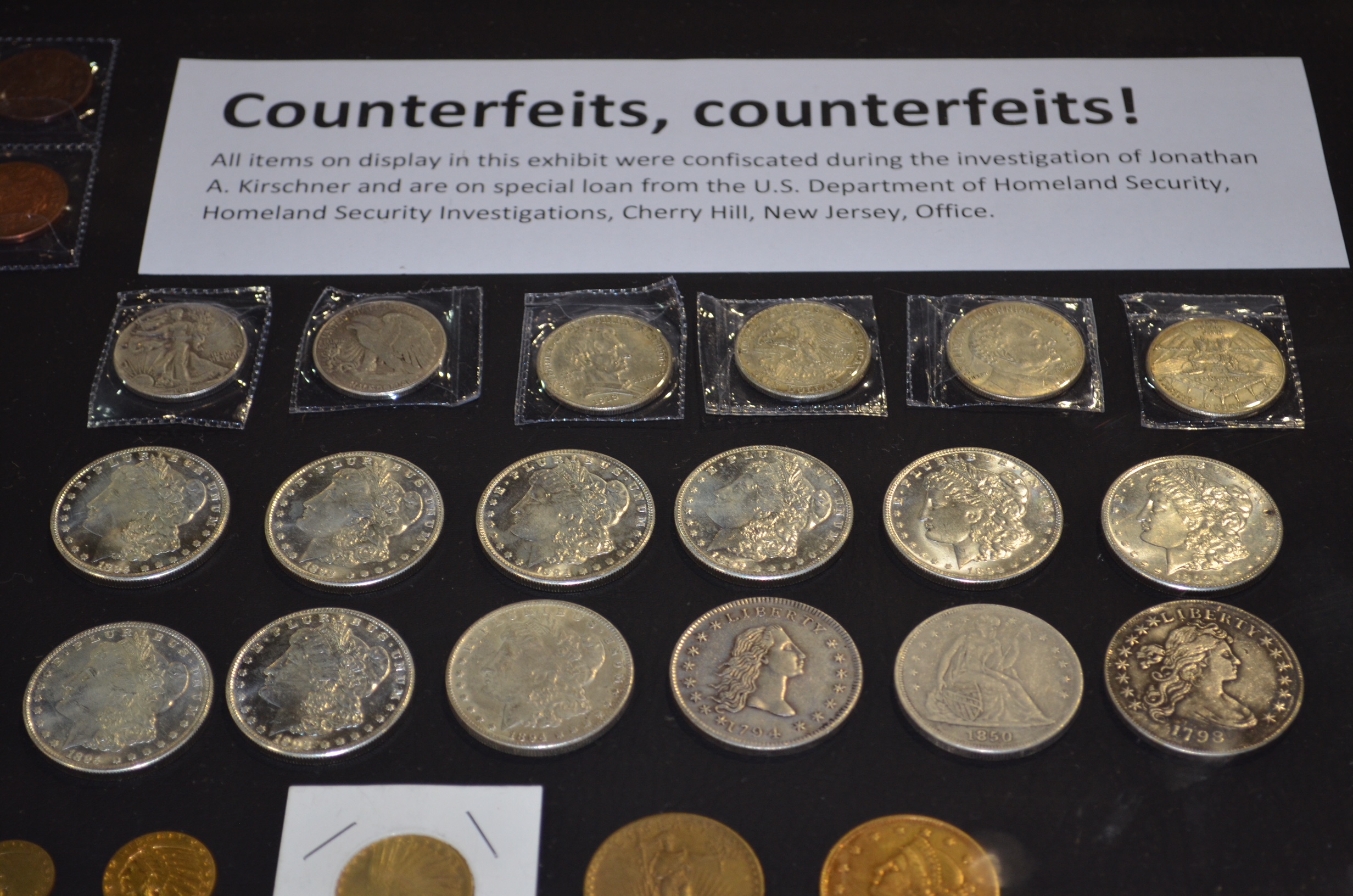
A portion of the exhibit of confiscated counterfeits on special loan from the Department of Homeland Security displayed at the 2018 World’s Fair of Money® by ICTA/ACTF.
Finally, it gives China a measure of moral superiority against the United States. After all, China figured out a way to prevent the impact of counterfeiting of older currency, why can’t the United States do the same?
China has no incentive to help the United States to solve a problem that they perceive does not exist. It is up to the United States to resolve these issues. This is why the industry promoted the Collectible Coin Protection Act (Public Law No: 113-288) so that law enforcement has an additional tool to use to help prosecute handlers of counterfeit coins in the United States.
You can read the original article
here.
Jul 25, 2018 | Canada, coins, foreign, news, other
With the outcry over the tariffs on Canadian goods being called a “National Security” issue, here is something from January, 2007 to consider.
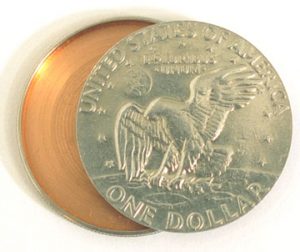
This photo released by the Central Intelligence Agency shows a hollow container, fashioned to look like an Eisenhower silver dollar, which is still used to hide and send messages, or film, without being detected. It is similar to the Canadian coin that was found on some U.S. contractors. Because it resembles ordinary pocket change, it is virtually undetectable as a concealment device.
(Image courtesy of the CIA via the AP)
Reports confirm that an unidentified Canadian coin was hollowed out and its metal replaced with the RFID transmitter. The coins were “planted” on three security cleared contractors between October 2005 and February 2006 as they traveled through Canada.
RFID transmitters can be used to track the movements of those carrying the coins. “You might want to know where the individual is going, what meetings the individual might be having and, above all, with whom,” said David Harris, a former Canadian Security Intelligence Service (CSIS) officer. “The more covert or clandestine the activity in which somebody might be involved, the more significant this kind of information could be.”

Reverse of a 2007 Canada Dollar nicknamed “The Loonie” because of the image of a common loon on its reverse.
(Image courtesy of the Carlyle Observer).
Although the type of RFID chip has not been identified, experts are saying that the transmitter in a coin would have a limited transmission range. It is said that the metal casing could constrain its range. Some of the technologies do have limited transmission ranges, but there are versions of the technology that could be tracked for a few kilometers.
“I’m not aware of any (transmitter) that would fit inside a coin and broadcast for kilometers,’ said Katherine Albrecht, an activist who believes such technology carries serious privacy risks. “Whoever did this obviously has access to some pretty advanced technology.”
The risk of the carrier spending the coin is great. but the ability to track a potential target would be a risk that spies might take. As our Canadian friends search their change, they may want to see if the coins have been hollowed and contain an RFID chip. That would be an interesting find!
The original article can be read
here.
Jul 18, 2018 | coins, foreign, nickels
This week’s LOOK BACK is from June 15, 2006. After a club meeting, I was inspired by two of the presentations.
Local coin clubs are a place you can regularly go to talk about coins and numismatics with like-minded collectors. If you have not attended a meeting you should find time to go. You might find that there is a learning experience that can inspire you in your collecting endeavors. One of the reasons I try to ensure I make it to the monthly meeting of my local coin club is because I seem to leave every meeting with an appreciation for something different about the hobby.
Our club encourages members to bring in their monthly finds. A numismatic show-and-tell. This week, Jerry Grzenda, a collector of many different types of coins and a serial exhibitor, showed his collection representing the last century of Iran. Jerry’s presentation included a history of Iran as seen through its coinage. It was a great learning experience and the coins were beautiful. There is something about the style of the Persian language that is intriguing and adds to the aesthetic of the coins.
Another highlight of the meeting was the presentation by Ron Brais about Hobo Nickels. While I have heard about Hobo Nickels, all I knew about them was what I learned in passing. In listening to Ron talk, I learned that the original Hobo Nickels were created between 1913 and 1935 using only Buffalo Nickels because the design had large figures on both sides that could be used as the basis of the design. The copper-nickel coins are also softer than others allowing them to be more easily carved. These elements allowed the carver to make just about any design and usually did. Designs were as varied as the artists who carved them. Hoboes would use the carved nickels to trade for food, shelter, or other favors during their travels.
The most famous Hobo Nickel artist was George Washington “Bo” Hughes. Bo ran away from home at a young age and was befriended by a hobo identified as Bert. After a train yard scuffle, Bert took Bo under his wings, protected him from the tramps and bums and taught Bo how to carve realistic images into the Buffalo nickel. For many years, Bo would ride the rails and carve nickels living the life of the hobo as he looked for work to survive. Bo’s work on Hobo Nickels allowed him to eventually get a job as a craftsman. It lasted until 1957 when he cut his left hand while carving a nickel. At that time Hobo Nickels were no longer popular and Bo just faded away. He died in 1982.
The life and history of George Washington “Bo” Hughes has been immortalized in the book Hobo Nickels by Delma K. Romines (out of print).
Today, the Original Hobo Nickel Society has a number of artist members that are carving images into Buffalo and Jefferson nickels to keep the art alive. Some of the designs are ingenious and beautiful while others are copies of carving on older coins. Modern nickels are made using modern tools that allow the carving to look much cleaner than their older examples. The old methods and tools were not able to make clean lines but it gave them a character that cannot be matched. To see the work of modern Hobo Nickel artists, follow @Hobo_Nickel_Soc on Twitter and try to resist not buying them!
The example of a Bo Hughes carved nickel displayed as part of the presentation beautiful in its design and execution. The care and craftsmanship that went into carving that coin was evident. Hobo Nickels can sell from $200-$1500 depending on condition and the artist. Coins by Bo Hughes are worth more than others.
Jun 17, 2018 | coins, foreign, gold, news
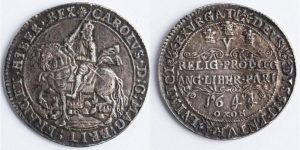
Thomas Rawlins Oxford Crown coin that minted in 1644. Only 100 of these coins were produced under the reign of Charles I.
(Image courtesy of The Sun.)
Workers cleaning out the cellar in an abandoned home in Brittany, a northwest region in France, discovered a shell-shaped container that rattled when shaken. Inside the container were 600 Belgian gold coins dated 1870. The obverse of the coins had the portrait of Leopold II, then the reigning monarch of Belgium.
Local media reported that the coins could be worth 100,000 euros or about $116,000 at the current exchange rate.
As reigning monarch in Belgium, as democratic reforms were sweeping through Europe, Leopold II had little power except to expand his empire. He did so by using explorer Henry Morton Stanley to help him lay claim to the Congo. Leopold was a harsh ruler in the Congo as he depleted the country of its two major resources: ivory and rubber. After, gaining a fortune Leopold basically went on a spending spree.
By 1908, Leopold was forced to give up control of the Congo to be managed as a legitimate Belgium colony. Belguim Congo gained independence in 1960 and became the Republic of the Congo.
There have been several hoards of Belgium gold coins from the Leopold II era that has been driving down the price of all coins. Add that European history does not portray him well makes his reign very unpopular.
The other find was by a woman in Hull, or more properly, Kingston upon Hull in the United Kingdom. She was cleaning out her loft and found a coin collection she inherited from her grandfather. She offered the coins to her children but they declined, believing the coins were junk.
Wanting to know more, she went to get the coins appraised and found that she had a Thomas Rawlins Oxford Crown coin that minted in 1644. Only 100 of these coins were produced under the reign of Charles I. It has an estimated value of £100,00 ($132,729 at the current exchange rate).
The lesson we should learn is to find those old boxes, containers, tins, or anything else that was given to you by a relative and do not assume it is junk. Have them appraised because you never know what you might find!
And now the news…

June 10, 2018
©Belga Demolition workers in the French town of Pont-Aven in Brittany have uncovered a fortune in Belgian gold coins worth €100,000. The coins date back to 1870, and show the notorious king Leopold II on the reverse.  → Read more at brusselstimes.com
→ Read more at brusselstimes.com

June 11, 2018
French gendarmes say workers paid to demolish an uninhabited house in Brittany made an unexpected discovery in the cellar — 600 gold coins. The Pont-Aven gendarmerie said the workers discovered the coins after rattling a mysterious, shell-shaped container.  → Read more at abc.net.au
→ Read more at abc.net.au

June 12, 2018
Liza Minnelli famously sang about the role of money in the award-winning Broadway play Cabaret, saying “Money makes the world go round.” Oscar Wilde cleverly wrote about it, as well, stating “When I was young, I used to think that money was the most important thing in life. Now that I am old, I know it is.”  → Read more at jasper52.com
→ Read more at jasper52.com

June 13, 2018
LOS ANGELES (Reuters) – A one of a kind 18th century gold coin bearing the likeness of the first U.S. President, George Washington, is expected to fetch more than $1 million when it goes up for auction in August, auctioneers said on Wednesday.  → Read more at in.reuters.com
→ Read more at in.reuters.com

June 13, 2018
A GRANDMOTHER found a rare 17th century coin worth £100,000 in a box of junk she was about to dump. The 69-year-old from Hull was clearing out her loft when she discovered the Thomas Rawlins Oxford Crown coin, minted in 1644.  → Read more at thesun.co.uk
→ Read more at thesun.co.uk

June 13, 2018
The South African Reserve Bank (SARB) has released the designs of its commemorative banknotes and coins for Nelson Mandela’s birth centenary, ahead of the launch on July 13. The central bank on Wednesday issued a statement indicating that test packs of the commemorative notes were made available to the cash industry to make preparations for cash processing, cash dispensing machines and ticket machines, among other things.  → Read more at fin24.com
→ Read more at fin24.com

June 16, 2018
Family Fortunes: A sniper shot and seriously wounded him in east Belfast in 1922  → Read more at irishtimes.com
→ Read more at irishtimes.com

June 16, 2018
A one of a kind 18th century gold coin bearing the likeness of the first U.S. President, George Washington, is expected to fetch more than $1 million when it goes up for auction in August, auctioneers said on Wednesday.  → Read more at reuters.com
→ Read more at reuters.com
May 27, 2018 | coins, currency, dollar, foreign
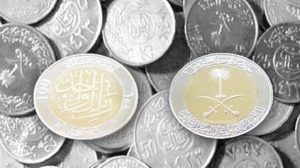
Saudi Arabia to replace the one-riyal note with coins (Image courtesy of Asharq Al-Awsat)
SAMA made the announcement as part of their introduction of new coin designs using modern techniques in coin manufacturing.
Under their transition plan, SAMA will allow the SR1 paper note to circulate alongside the new coin as the notes will be withdrawn from circulation. When the coins become available, the banks will be ordered to replace the SR1 note with a coin based on an availability formula that will be provided when the coins are ready for circulation.
According to Society for Worldwide Interbank Financial Telecommunication (SWIFT), the company that runs the network that enables the world’s financial institutions to security send financial transactions to each other, the United States dollar makes up 40.86-percent of every transaction in the world (as of February 2017). The United States Gross Domestic Product (GDP), the measure of an economy’s output, is over $19 trillion (in 2017 according to the International Monetary Fund) more than any country or trading cooperative (such as the European Union). But the United States is the only country ranked in the Top 10 of either of these lists to continue to produce its unit currency in paper form.
For a country that is supposed to be a leader, it looks like the United States has fallen behind the rest of the world. It is time to eliminate the one-dollar Federal Reserve Note.
And now the news…

May 20, 2018
A new £1 coin could actually end up earning you hundreds thanks to a Royal Mint 'error'. Three examples of the error have already been seen by ChangeChecker – and they are selling for more than £200.  → Read more at bristolpost.co.uk
→ Read more at bristolpost.co.uk

May 22, 2018
Prosecutors won’t pursue charges against a drummer accused of stealing rare coins and a passport from famed New Orleans musician Fats Domino.  → Read more at pagesix.com
→ Read more at pagesix.com

May 22, 2018
The sifting project, which has operated since 2004 in the Emek Tzurim National Park, aims to salvage religious and historical artifacts from the rubble, as well as to educate the public about the veracity of Jewish history on the Mount.  → Read more at jns.org
→ Read more at jns.org

May 22, 2018
Aaron Judge and Michael Conforto are two of the young stars that New York baseball fans have been buzzing about the past two years. Now fans of the Yankees and Mets outfielders can now get the star…  → Read more at nysportsday.com
→ Read more at nysportsday.com

May 24, 2018
2018 Baseball Treasure MLB Coins checklist, release date, silver and gold coin info and all you need to know about the officially licensed set of baseball coins.  → Read more at beckett.com
→ Read more at beckett.com

May 25, 2018
The much-ballyhooed summit between the United States and North Korea met its end Thursday. The cancellation, for now, stamps out the prospects for peace, yet does nothing to stop the snazzy coins featuring Donald Trump and Kim Jong Un in front of patriotic backdrops surrounded by olive branches  → Read more at cnn.com
→ Read more at cnn.com

May 25, 2018
The Saudi Arabian Monetary Authority (SAMA) will start withdrawing SR1 banknotes from the market from Thursday, SAMA has said. In a statement, SAMA announced issuing its sixth edition, which was developed during the reign of the Custodian of the Two  → Read more at aawsat.com
→ Read more at aawsat.com
May 10, 2018 | coins, foreign
Sometimes it can be fun to search through junk boxes or bags of foreign coins. While you can see a lot of the same coins accumulate in these bags there are others that look interesting.
During our local coin club meeting, members bring in coins to sell to other members. One member, a very prolific collector, had a large plastic bag of circulated foreign coins. I was first drawn to the back by some of the shapes I found. I grabbed a handful and one coin fell on the table that really caught my eye.
It was a small coin. A very small coin. Nobody had a caliper but it was really small. Even though I was looking at the different shapes, I found this very small round coins intriguing. What was it?
Although I should become better at recognizing languages that are not based on the Latin alphabet, I asked my fellow club member if they could help identify the coin. He said that he could not identify the coin but recognized the lettering as being from India.
With that knowledge, I did not have to search the entire Standard Catalog of World Coins to figure it out. Start at the beginning of the Indian coins and see what we could find.
After a few minutes of looking, I found the listing. Then I found a second one that was very similar. Which coin did I have and where did it come from?
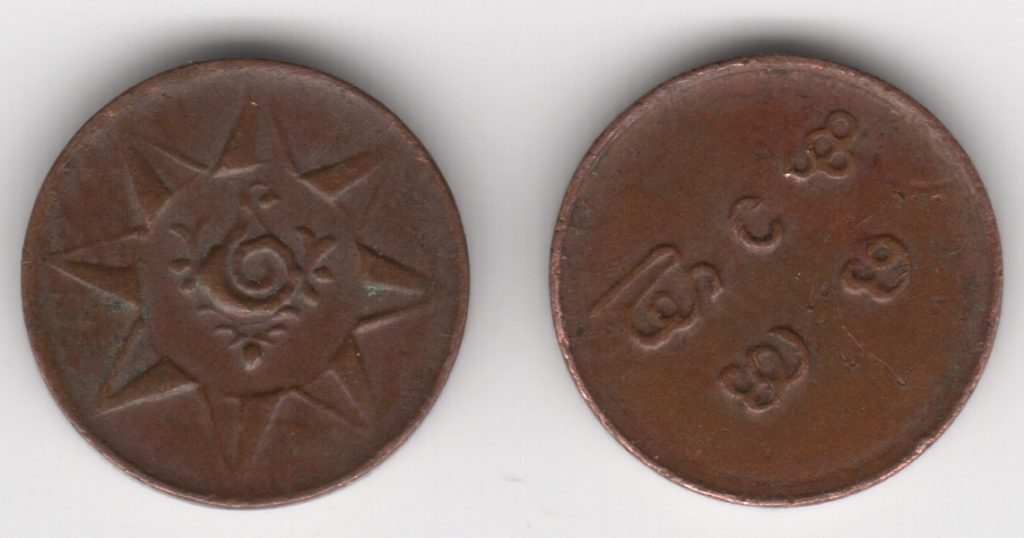
Travancore One Cash coin (KM #40). Undated but was struck from 1901 through 1910.
The coin is from the Princely State of Travancore. It was located in the southwest of the Indian subcontinent. Travancore became its own state in 1729 when it passed under Muslim control. Its economy was driven by making an alliance with the East India Company to freely use its ports for trade. Because of this arrangement, Travancore was never a part of the British Empire and continued to remain independent until 1949 when India was united as one country.
Only two rulers issued coins in the State. Rama Varma VI lead from 1885 through 1924 and Bala Rama Varma II ruled from 1924 through the end of the kingdom in 1949. Coins were issued by the kingdom to make up for lost revenues when the British became distracted by other world events.
Regardless of which version of the coin, it is a “ONE CASH” coin made of copper. The obverse is a sankha (conch shell) in an 8-pointed star with the reverse reading “Onu Kasu’ (one cash).
One version, under the rule of Rama Varma VI, was .65 grams of copper (KM #40) and the other, under the rule of Bala Rama Varma II, is .48 grams of copper (KM #57). Since my scale is not that sensitive, I had to find another way to diagnose this coin.
According to the SCWC, KM #57 was struck on a thin planchet that measures .8 mm. After making sure that my digital caliper can measure 1 mm, using a piece of metal that is 1 mm thick, I would be reasonably certain I could determine which coin I have.
Measuring both coins, the caliper read 1.02 mm giving evidence that this is the early version of the coin (KM #40)
Given the difference of only .22 mm, the only way to tell the difference would be either to weight the coins or use a caliper.
Since I had the caliper out, I measured the diameter and found it to be 10.72 mm.
For fun, I had to determine whether it was smaller than the 1904 Panama 2½ Centesimos coin, better known as the Panama Pill. Previously, I wrote that the Panama Pill was 10 mm in diameter. After finding the coin and measuring it, it was 10.12 mm in diameter making it than a little more than a ½ of a millimeter smaller than the Travancore One Cash coin.

Travancore One Cash coin from the early 20th century versus the 1904 2½ Centesimos coin, better known as the Panama Pill.
On a quick look, it appears that the most common “small” coin size is 15 mm. Some are slightly larger but not many smaller. The only other coin I found is a British 1½ pence coin that was struck for Ceylon, British Guiana, British West Indies and Mauritius that is 12 mm in diameter, I cannot find any smaller.

Surrounding the United States Dime is a 1904 Panama 2½ Centesimos coin (Panama Pill) and a 1901-1910 Travancore One Cash coin.
If anyone knows of smaller coins, please let me know.
Apr 14, 2018 | currency, foreign, fun
When I go picking I look for the unusual. Whenever I walk into an estate sale or any other picking opportunity, I will find the most remote area and work from there. In most homes, I head for the basement and the garage. These are the places that people store things they did not want to throw out, It is where I find the most unusual items.
Lately, I have been finding that buying old books can be just as interesting. Aside from cultivating a small clientele of interested customers, I have found that people hide things in books, especially old books.
Not long ago I visited a difficult to find estate sale hoping to find something interesting. I did not find much but there were some books that had possibilities. At $2 each, I felt I could find a few gems.
Based on the type of books I found, the owner had a passion for European history. In addition to travel books and books about European influence on United States society, there was a two-volume set written in French.
My French is good enough to figure out that the books were published in 1899 Paris and were from the first printing of the first edition. For book collectors, once the book meets the condition test, these are the books they like. Since they were in good condition with nice covers I added them to my pile.
This past week I was going looking through the box of books. As I was cataloging them I will either scan the pages or fan them to see if I find something. Within these two volumes of French language books on European history, I found money.
I was a little surprised to see notes from the Central Bank of Egypt. Seven different Egyptian notes, mostly from the late 1980s. The face value of the notes totals 13 pounds.
-

-
Obverse of the Egyptian banknotes found in a French language book about European history.
-
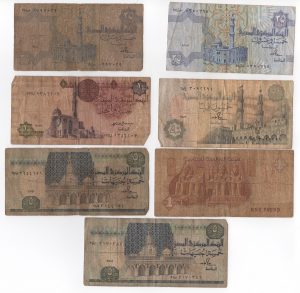
-
Reverse of the Egyptian banknotes found in a French language book about European history.
Aside from being mostly in horrible condition, I do not recall any indication of books, magazines, or catalogs referencing Egypt of the Middle East or North Africa.
The best-looking note is a 25 piastre note (Pick #57a) but it looks water damaged. It was probably water damaged before being stored between the pages of the book since the book shows no effects from the storage.
Although the notes can be worth $5 for the 25 piastre note to $25 for the 5-pound note, that would be if they were in better condition. I am not sure the entire lot is worth $5!
The moral of this story is that if you go picking at estate sales, check the bookcase. You never know what might fall out when you fan the pages.







 → Read more at
→ Read more at 














